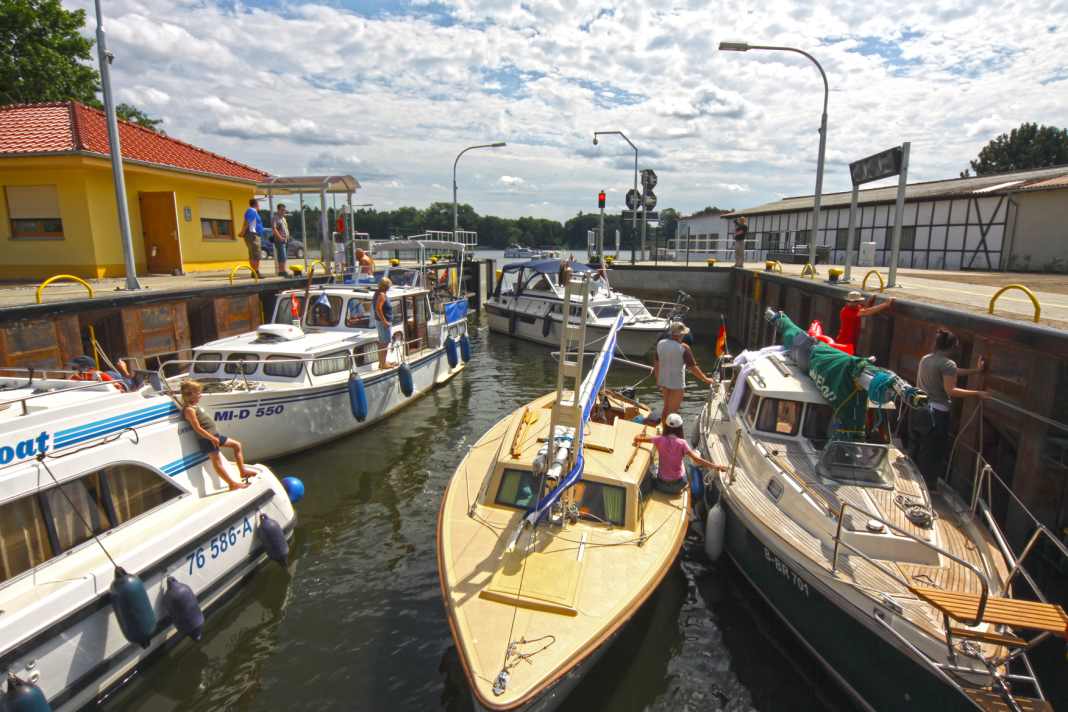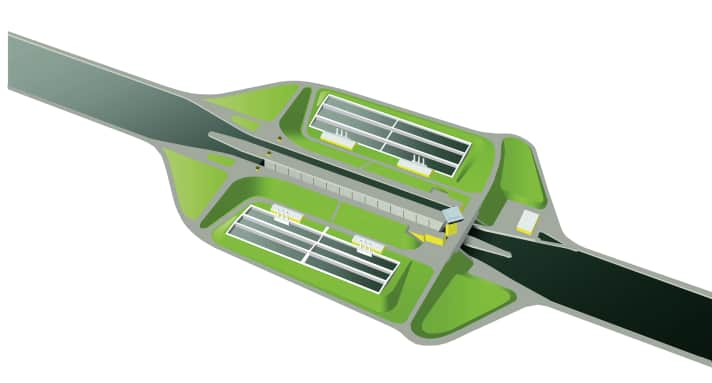




Entering the lock: You should only set off when the signal really shows green. Even if the chamber already appears empty, an unexpected latecomer may still come out. If it switches back to red, you have to return to the waiting area, even if the gate has almost been passed. Rushing ahead will not change the lock keeper's mind.
If you are alone, you usually have a free choice of seats in the chamber. If there is more traffic, follow the instructions of the lock staff, who have the most experience in "sorting". You will never be overtaken in the lock! If you are instructed to enter the lock alongside another boat, fender off this side particularly well.
New lock walls are usually made of smooth concrete (good) or steel sheet piling (less good, see above), older ones are sometimes still brick-built. A rare speciality are locks with sloped (i.e. inclined) chamber walls, which were built where the subsoil was less firm; however, their number is very small.
The line guide
Cabin boats and larger yachts must be secured with at least two lock lines; for small boats, one line amidships may be sufficient - but this depends greatly on how much movement there is in the water. A lock hook can be very helpful in order to "hook on" to a ladder or a climbing pole. Although frequently observed, boat hooks are only suitable in the lock for putting a line over a bollard; the leverage ratio (and the rather small hook) are unsuitable for holding the boat against the chamber wall.
In addition to ladders and climbing poles, bollards embedded in the wall are of course also suitable for guiding lines. Large shipping locks are also often equipped with so-called floating bollards; they run in guide rails so that they rise and fall with the water level. All lines must always be guided on a slip and must never be tied up - if a boat is intentionally or unintentionally "hung up on the cleat" due to a knot during the valley lock, it can quickly become expensive!
The jamb
Also beware of the yellow jamb markings: the actual lock chamber is limited by the gate niches. However, its "usable length" is shorter; it lies between the sill markings. Boats in the lock must not exceed this marking, as they could otherwise sit on the upper sill when passing through the valley.
Once you are safely moored, the engine is switched off so that the lock chamber does not become a smoking chamber (especially for paddlers!). But before we continue, let's take a quick look at the different lock operating modes.
Self-service operation
Many locks in recreational boating areas are now designed for semi-automatic self-service operation. This means that the crew no longer have to use their muscles to open and close the gates and gates, but can initiate the lock from on board - by turning the so-called "request switch".
There is no longer a lock keeper on site, but there is usually a call system in case of problems and the area is monitored by video camera. Locks of this type can be found more and more frequently on the widely ramified waters of Mecklenburg and Brandenburg - either as new replacements or refurbished.
The request switches are usually blue, but green is also used. There is also a panel with operating instructions in the immediate vicinity. When the bar is turned, a signalling light at its tip begins to light up - the request has been registered by the automatic system. The instructions on the illuminated sign and the traffic light signals must now be followed.
After entering the chamber, the "continue lock switch" (in the same colour) is only turned when all boats in the lock signal that they are ready. The red bar may only be turned in an emergency; it interrupts the current lock-out and the control centre is alerted. Rescue equipment is located on land.
Self-service is not (yet) an option in the large shipping sector; however, more and more locks are being converted to remotely monitored operation, in which an entire section of the waterway is controlled from a control centre at the touch of a button. However, the majority of locks are still staffed during operating hours.
The lock
How the actual locking process works has already been described in here explained. Of course, valley launching is easier in several respects: there are hardly any eddies and currents, and the boat rarely pulls on the lines despite the suction. If the drop height is not too great, the lines can be left lying comfortably on the bollard at the edge of the chamber and only need to be lowered to slip, but not folded over. Once at the bottom, one end is simply pulled off (of course you have to be sure that the line is long enough for this beforehand).
As mentioned above, things can get a little rougher during upstream sluicing, especially in smaller locks. The most important thing to remember is to always move the lines to a higher point in good time. Do not wait until the bollard with the line disappears below the waterline - even a line on a slip can get snagged.
And don't be afraid of silt and dirt on the chamber wall, better put on old work gloves. Incidentally, the skipper's duties also include keeping an eye on the other vehicles around them. Is everything going as smoothly there as it is on board? A free fender that can be deployed quickly in a vulnerable spot prevents dents.
When travelling out, give way to canoeists and kayakers if possible. You should only start the engine when the gate opens and only release the lines when you have the green light and the way is really clear.
In an emergency
If an emergency does occur and a line becomes snagged and can no longer be released under tension, draw attention to your situation as quickly as possible so that the lock can be stopped - either by another crew (in the case of a self-service lock) or by the lock staff. A Life jacket can generally do no harm in the lock.
Before locking and in the lock chamber: how to behave correctly

Before the lock
Commercial shipping always has right of way - so there are a few important points to bear in mind even before you reach the lock:
- Log in: Call the lock a few kilometres in advance by radio or telephone, tell them who you are and where you want to go. This way you will not be overlooked later at the waiting area and can be scheduled by the lock staff.
- Watch out: Always moor at the designated waiting area for pleasure craft. Wait for instructions (by radio or loudspeaker). You will be told exactly when you can enter behind which commercial vessel.
- Patience: Don't get impatient! You will not be forgotten, but if there is a lot of traffic, the wait may take a little longer. This also applies when there is little traffic - pleasure craft are almost never locked alone at large locks in order to save water.
In the lock chamber
Attention, order! Pleasure craft always arrive after commercial shipping:
- Fixed place: They will usually tell you where you can moor. But it doesn't matter how much space you have (or don't have): Under no circumstances should you overtake a commercial vessel that is already moored.
- Floating bollards: As helpful as this technique is, the bollards can get caught in their guides. For this reason, always leave your lines loose on the slip, even with floating bollards, so that they can be released quickly.
- Exit: Only set off when the commercial vessel has moved away a little. Its propeller water can cause a lot of turbulence in the water when starting off!

